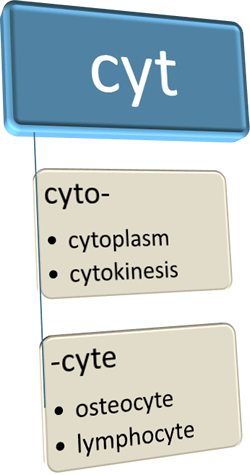Even if they know what roots, suffixes, and prefixes are, most of them don't know the literal meanings of "meta," "juxta," "reno," or "cyto." If they pick up these word parts as they learn, however, they can quickly get comfortable with the language of science and medicine—and really ramp up their learning of core concepts.
In The Human Body in Health & Disease, we have woven language learning into every chapter so that students can more efficiently master the language of science and medicine.
Nearly every anatomy and physiology and patho teacher I know mentions word parts frequently in class discussions—especially when introducing the more convoluted terms that represent important concepts.
Besides breaking down impossibly long words into easily consumed, bite-sized pieces, it's also a stealthy strategy to "sneak in" some language learning. Without having to "put it on the test" we can introduce word parts— and how they are used to construct phrase-like terms—in a way that allows natural language learning. Students often don't even realize that our repeated mentioning of the meaning of common word parts is adding to their mental lexicon. Soon they start recognizing these word parts on their own.
When students know what common word parts mean, they start using them as mnemonic tools (memory aids). They find themselves using the word parts as clues to remember the actual working definition of the term—and the essence of the concept that the term represents.
In The Human Body in Health & Disease, we support this widely used classroom approach in several ways. A central strategy is our inclusion of word parts in the chapter word lists.
Previewing unfamiliar words before reading a chapter helps to get those words into the reader's mental lexicon more quickly—and how that, in turn, improves reading comprehension. Because we also include word parts in the chapter word lists, scanning these lists naturally builds competence in scientific and clinical language.
A widespread and effective strategy in teaching reading skills—from elementary school to advanced courses in college reading efficiency—is often called word study. In a nutshell, word-study instruction encourages readers to strengthen their recognition of word patterns as first step, rather than simply memorizing new words as they encounter them. This is based on the fact that we read words and phrases as a whole. It's one of many brain-based strategies of learning that translate current concepts of neuroscience into practical strategies.
Incorporating word parts in the chapter word list, where they can be scanned before reading the chapter, offers the opportunity for readers of The Human Body in Health & Disease to make the word study method part of their overall reading strategy. By building pattern-recognition skills, readers can better get new terms into their mental lexicon and thus be able to read them without stumbling and thus learn concepts more efficiently.
But wait! There's more! In The Human Body in Health & Disease, we provide even more built-in tools to help students gain skill in using their new language. In an upcoming post, I'll point these out.
Article content adapted from Anatomy & Physiology



No comments:
Post a Comment